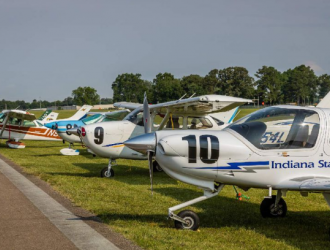
“The establishment of a new entity separate of the FAA raises serious concerns regarding the disposition of certain unique National Defense procedures, programs and policy. It is significant to note that the DOD relies on FAA ‘command and control’ capabilities in the execution of the National Defense mission,” the PBFA stated.
Any agreement that creates a new ATC organization, the board said, must take into account shared-infrastructure issues such as military drones transiting the airspace, interoperable communication, navigation and surveillance systems and delegation of authority to the military for special use airspace.
FAA air route traffic control centers that manage high-altitude airspace delegate authority to DOD controllers for operations in special use airspace and in terminal areas surrounding military airfields. “DOD and FAA air traffic controllers interface to effect arrival, departure and enroute coordination and transfer of control from one facility to another on a real-time basis,” the board said. “DOD controllers provide service to any aircraft that transits their assigned airspace. There are numerous examples wher DOD controllers provide services into/out of civilian/commercial airports.”
While DOD military or civilian controllers typically staff the ATC towers at military airfields, “there are unique examples wher DOD control towers are staffed by FAA civilian controllers,” the board said, citing Joint base Andrews in Maryland and Joint base Pearl Harbor-Hickam in Hawaii as examples.
Analyses by airspace and air traffic offices of the military services indicate that the DOD provides some 15 percent to 20 percent of air traffic services capability to all users of the National Airspace System, according to the PBFA. The military contributes by allowing private and commercial aviation access to the Air Force-operated GPS satellite constellation and providing air traffic and long-range radar surveillance, navigational aids and ATC personnel.
The PBFA includes representatives of the military services, the Office of the Secretary of Defense and the joint staff of the U.S. Northern Command and North American Aerospace Defense Command.
The board said it “reviewed and discussed” the legislation Shuster introduced last year in the previous Congress—H.R. 4441—which proposed creating a “federally chartered, not-for-profit corporation” to provide air traffic services in place of the FAA. An 11-member board of directors consisting of a CEO, two directors appointed by the secretary of Transportation, four directors representing airlines, two directors representing general aviation, and one director each representing controllers’ and pilots’ unios, would manage the corporation. The DOD was mentioned as serving on an advisory board of not more than 15 individuals representing various other parties.
based on its review of the previous bill, “PBFA representatives assert that consideration must be given to including seats on any form of Air Traffic Services Corporation Board of Directors, Air Traffic Procedures Advisory Committees, etc.,” the DOD board said.
Shuster’s committee advanced the legislation to the House floor, but it never came to a vote. Legislation the Congress passed last July to extend the FAA’s funding through September this year omitted language to create a separate ATC organization.
The focus has shifted now to the next FAA reauthorization bill. Shuster, commenting on a January 11 report by the Department of Transportation inspector general on the agency’s contingency planning for ATC system disruptions, said the IG’s findings add “to the sea of evidence supporting the need for real reform in modernizing and managing air traffic services, and letting the FAA focus on its safety mission.” The lawmaker has said that he is prepared to “speak with anyone who can improve on our proposal” from the last Congress, The Washington Post reported.
In opening remarks that he made on January 11 during the confirmation hearing for Elaine Chao, President Donald Trump’s nominee to serve as secretary of Transportation, Sen. Bill Nelson (D-Fla.) said there is “total opposition” within the DOD to creating a separate ATC organization. “Besides being costly and disruptive in implementation…this scheme would upset the partnership between the FAA and a lot of the agencies of government,” he added. Chao said she’s aware of the arguments for and against the proposal, but she remained noncommittal on her position.



